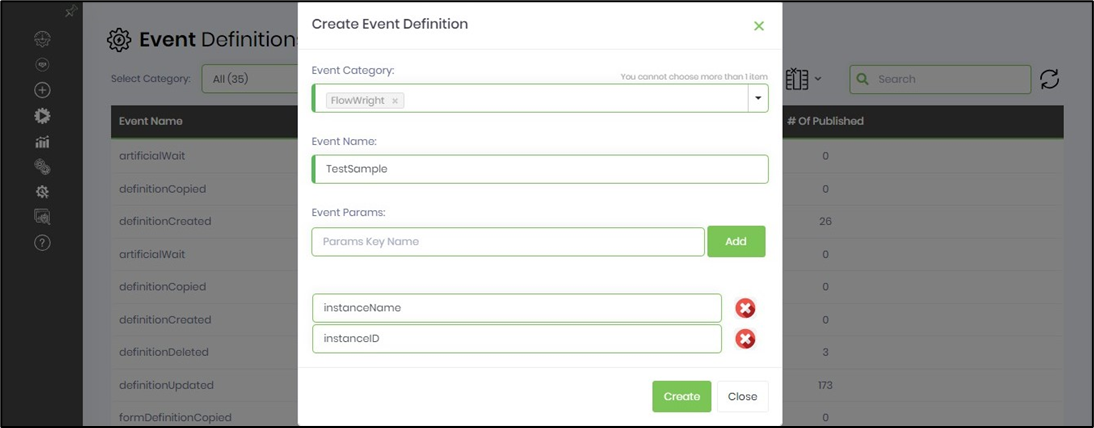The user can manage event definitions and parameters, export and import definitions between FlowWright environments, and understand usage patterns.
On the ESB page, navigate to the ESB - Event Definitions menu.

The Event Definitions UI is rendered below. The events are ordered by name, and there is a category drop-down list and search box to narrow down to a specific event.

Create Event Definition.
This function lets you create an event definition.
On the Event Definitions page, select the Actions - Create menu option.

The Create Event Definition pop-up is displayed for configuration. Select the event category from the drop-down list. Provide an event name. Use the Add button to add event parameters. Use the (x) buttons to remove the event parameters. Click on the Create button to confirm. The event definition is created, and a confirmation message is displayed in the top-right corner.

Edit Event Definition.
This function lets you edit an event definition.
Select a definition on the Event Definition page and click the Actions - Edit menu option.

The event definition pop-up is rendered with details for changes. Select the event category from the dropdown list. Provide the event name. You must “Add or Remove” the event parameters. Click the UPDATE to confirm the changes. A confirmation message is displayed in the top-right corner for a successful update.

Remove Event Definition.
This function lets you remove an event definition from the list.
On the Event Definitions page, select a definition from the list and click the Actions - Remove menu option.

The Remove Event Definition pop-up window appears for confirmation. Click OK to continue. The definition is removed from the list, and a confirmation message is displayed in the top-right corner.

View Parameters.
This function lets you view the parameters for an event definition.
Select a definition on the Event Definition page and click the View - Params menu option.

The parameters and default values are rendered in a pop-up window, as shown below.

Usage.
This function displays the event definitions usage as a bar graph.
On the Event Definitions page, select the View - Usage menu option.

The usage bar graph is rendered with a category filter to view the list.

Export.
This function lets you export the event definitions as an XML file. Using an import function, you may move the definitions between FlowWright environments.
Please select an event row from the table on the Event Definitions page or search for an event by its name. Then, click the Export—XML menu option.

The file is exported as XML and downloaded to a local folder. I've included a sample XML here for you to look over.
<eventDefinitions><eventDef category="FlowWright" name="definitionCreated" /><params>
<item key='definitionID'></item>
<item key='definitionName'></item>
<item key='externalUserName'></item>
<item key='userID'></item>
</params></eventDefinitions>
Select an event row from the table or search for an event by name. Click on the Export—SQL menu option. The file is exported as SQL and downloaded to a local folder. A sample SQL is included here for reference.
INSERT INTO [deEventDefinitions] ([EVENTDEFID],[EVENTCATEGORY],[EVENTNAME],[PARMSXML],[CREATEDATETIME]) VALUES('6fd76ec9-4772-4c33-bca4-5e042ce3788c','FlowWright','definitionCreated','<params>
<item key='definitionID'></item>
<item key='definitionName'></item>
<item key='externalUserName'></item>
<item key='userID'></item>
</params>','2023-08-02T05:01:33')
Import.
This function lets you import XML event definitions to the FlowWright environment.
Please select an event row from the table on the Event Definitions page or search for an event by its name. Then, click the Import—XML menu option.

The Import Event Definition pop-up window is displayed for configuration. Click the Choose File button to import the XML file from the local folder. Click the Import button to confirm. The event definitions are imported, and a confirmation message is displayed in the top-right corner.
